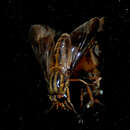en
names in breadcrumbs


This species is in no danger of extinction.
US Federal List: no special status
CITES: no special status
State of Michigan List: no special status
Complete larval development in the family Tabanidae generally takes about a year, although some species require two or more years. Eggs are laid in large batches in or near water, and the larvae of this species can be found at the margins of streams and ponds, or in wetland soil. Although the larvae live in water, they do not have gill-like structures for breathing oxygen, so they must come to the surface to breathe. When the pupae are formed they can be found in dead vegetation above the free-water level. After adults emerge the mating cycle begins again.
Development - Life Cycle: metamorphosis
This species can be quite an annoying pest during the summer months. Although a painful bite and a small welt is the extent of harm done to the body, these flies can discourage tourists from visiting the recreational areas that the species inhabits.
Negative Impacts: injures humans (bites or stings)
Species Used as Host:
Chrysops is a genus of parasitic flies that feed on the blood of mammals. Female adults gorge on blood by cutting the skin with their modified mouthparts and sucking the blood from the wound. Males lack these piercing mouthparts, and generally feed on the nectar of plants. Larvae of this species feed on organic debris found in their surrounding environment. Larvae can also be predaceous, feeding on other insect larvae or worms. In rural areas of the eastern United States, there is a large population of deer (Odocoileus), which are an excellent source of food for C. vittatus.
Animal Foods: blood; insects; terrestrial worms
Plant Foods: nectar; pollen
Primary Diet: carnivore (Sanguivore ); herbivore (Nectarivore )
Chrysops vittatus can be found in the eastern half of the United States and the southeastern part of Canada.
Biogeographic Regions: nearctic (Native )
Species in the genus Chrysops are found in open woodlands and wetland areas, especially near the margins of streams and ponds.
Habitat Regions: temperate ; terrestrial ; freshwater
Terrestrial Biomes: forest
Aquatic Biomes: lakes and ponds; rivers and streams
Other Habitat Features: riparian
Deer flies (Chrysops spp.) are generally smaller in size (10-12mm) than their cousins the horse flies (Tabanus spp.). Chrysop vittatus is known as the striped deer fly due to the three longitudinal stripes on its thorax, and four stripes on its broad, blunt abdomen. The entire insect is yellowish in color, and the antennae have three functional segments with the distal segments being fused. Large, laterally extended, iridescent eyes are characteristic of the entire Tabanidae family. Female C. vittatus have a space between the compound eyes while males do not. Females have mouthparts modified for piercing flesh. There are two flattened mandibles with serrations, two narrow, serrated maxillae, a hypopharynx, and a median labrum-epipharynx. The mandibles cut the integument and the maxillae pierce the tissue, rupturing the blood vessels. The food canal is formed by the hypopharynx and labrum-epipharynx.
Range length: 10 to 12 mm.
Other Physical Features: ectothermic ; heterothermic ; bilateral symmetry
Sexual Dimorphism: sexes shaped differently
Little information is available on the exact mating behaviors of Chrysops vittatus.
Adult flies mate relatively quickly after emerging, and oviposition depends on the female having a blood meal. The blood meal serves as nourishment for the eggs' maturation. Eggs are laid in large batches in or near water and the larvae of this species can be found at the margins of streams and ponds or in wetland soil.
Key Reproductive Features: sexual ; fertilization (Internal ); oviparous
Once eggs are laid in a suitable location for larval development, there is no further parental investment.
Parental Investment: pre-fertilization (Provisioning, Protecting: Female)
Chrysops vittatus is a species of deer fly in the family Tabanidae.[5][6]
United States and Canada.